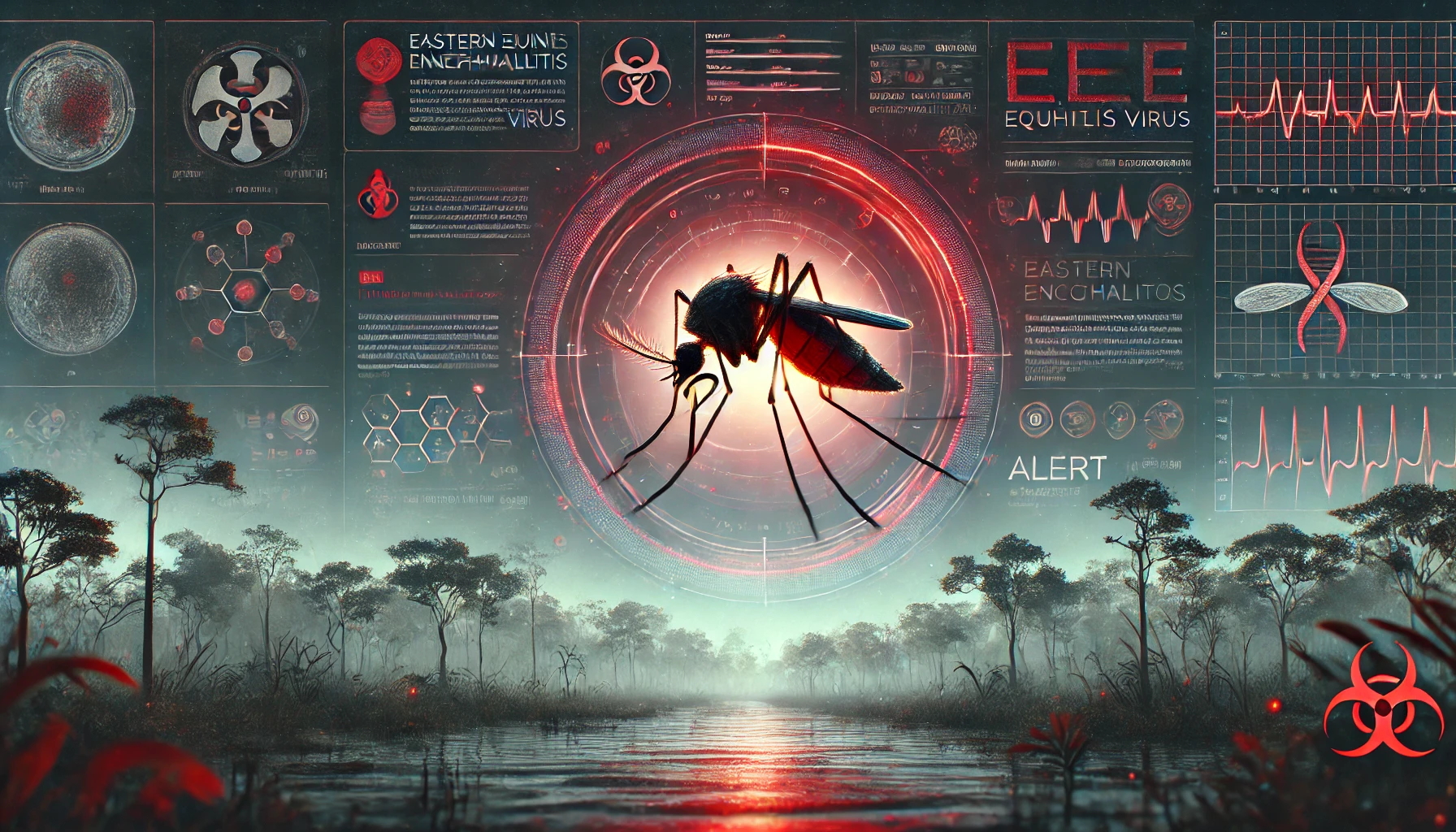Deadly Impact of the EEE Virus: What You Need to Know
Deadly Impact of the EEE Virus: Eastern Equine Encephalitis (EEE), also known as Triple E, is one of the most dangerous mosquito-borne diseases in the United States. This rare but deadly virus can lead to severe brain inflammation, causing significant health complications and even death. As the number of EEE virus cases rises, understanding its symptoms, impact, and how to protect yourself is more critical than ever.
In this blog post, we will delve into the symptoms of the EEE virus, its deadly impact, and what measures you can take to safeguard yourself and your loved ones. By the end of this article, you will be well-informed about the risks associated with Triple E and how to mitigate them effectively.
What is the EEE Virus?
Eastern Equine Encephalitis (EEE) is a viral disease that affects both humans and animals. The virus is primarily transmitted through the bite of an infected mosquito, which has previously fed on an infected bird. While it is relatively rare, the consequences of contracting the EEE virus can be severe, particularly for those who develop encephalitis, an inflammation of the brain.
The EEE virus is most commonly found in the eastern United States, particularly in states with large wetland areas where mosquitoes thrive. Although the virus can infect horses, birds, and other animals, humans are at significant risk, especially during the warmer months when mosquitoes are most active.
Triple E Virus Symptoms: Recognizing the Signs
Understanding the symptoms of the Triple E virus is crucial for early detection and treatment. The symptoms typically appear four to ten days after a person is bitten by an infected mosquito. The severity of symptoms can vary widely, with some individuals experiencing mild flu-like symptoms, while others develop severe neurological complications.
Mild Symptoms
In the early stages, the EEE virus may present with symptoms similar to those of the flu, which can make it difficult to diagnose initially. Common mild symptoms include:
- Fever (often exceeding 104°F)
- Chills
- Joint pain
- Muscle aches (myalgia)
- Headache
- Fatigue
These symptoms can last for one to two weeks and may resolve on their own. However, it is essential to monitor the situation closely, as the virus can quickly progress to more severe symptoms.
Severe Symptoms
In more severe cases, the EEE virus can lead to encephalitis, a condition that causes inflammation of the brain. This is where the virus earns its reputation as one of the deadliest mosquito-borne diseases. Severe symptoms of EEE include:
- High fever
- Severe headache
- Stiff neck
- Confusion and disorientation
- Seizures
- Paralysis
- Coma
The onset of these severe symptoms is rapid, and the condition can deteriorate quickly, leading to permanent neurological damage or death. It is estimated that about 30% of people who develop encephalitis from the EEE virus will die, and many survivors are left with long-term disabilities, such as memory loss, personality changes, or physical impairments.
Eastern Equine Encephalitis Deaths: A Deadly Consequence
The high mortality rate associated with EEE is what makes this virus particularly concerning. Eastern Equine Encephalitis deaths, although rare, are a stark reminder of the virus’s potential to cause significant harm. In recent years, there have been several documented outbreaks in the United States, leading to multiple fatalities.
Statistics and Case Studies
According to the Centers for Disease Control and Prevention (CDC), there are typically only a few cases of EEE in humans each year in the United States. However, during outbreak years, the number of cases can increase significantly. For example, in 2019, there were 38 confirmed cases of EEE in humans across the United States, resulting in 15 deaths. This was one of the deadliest years on record for EEE.
The high fatality rate is primarily due to the rapid progression of the disease once severe symptoms set in. Without prompt medical intervention, the chances of survival decrease dramatically.
Long-Term Impact on Survivors
For those who survive EEE, the road to recovery can be long and challenging. Survivors often face months of rehabilitation to regain basic functions and cope with the lasting effects of the virus. Common long-term complications include cognitive impairments, motor skill deficits, and behavioral changes. The financial and emotional toll on survivors and their families is immense, making prevention and early detection all the more critical.
EEE Virus Outbreak 2024: Current Trends and Areas at Risk
As of 2024, health authorities are closely monitoring potential outbreaks of the EEE virus, particularly in regions where the virus has previously been detected. The EEE virus outbreak 2024 has raised concerns among public health officials, especially in areas with favorable conditions for mosquito breeding.
Geographical Hotspots
The northeastern United States, including states like Massachusetts, Maine, and Michigan, have historically seen higher incidences of EEE. These areas, characterized by wetlands and marshes, provide ideal breeding grounds for mosquitoes, which can then spread the virus to humans and animals. Public health campaigns in these regions are emphasizing the importance of mosquito control and personal protection measures to prevent the spread of the virus.
Climate and Environmental Factors
The EEE virus is heavily influenced by climate and environmental factors. Warmer temperatures and increased rainfall can lead to higher mosquito populations, thus increasing the risk of virus transmission. Climate change may further exacerbate this issue, leading to more frequent and widespread outbreaks of mosquito-borne diseases like EEE.
Preventing Triple E Virus: Protecting Yourself and Your Community
Given the deadly nature of the EEE virus, prevention is crucial. While there is no vaccine available for humans, there are several strategies you can employ to reduce your risk of contracting the virus.
Personal Protection Measures
- Use Insect Repellent: When spending time outdoors, especially during dawn and dusk when mosquitoes are most active, apply insect repellent containing DEET, picaridin, or oil of lemon eucalyptus.
- Wear Protective Clothing: Long sleeves, pants, and socks can provide a physical barrier against mosquito bites. Light-colored clothing is less attractive to mosquitoes.
- Avoid Peak Mosquito Hours: If possible, limit outdoor activities during early morning and evening hours when mosquitoes are most likely to bite.
- Secure Your Home: Ensure that windows and doors are properly screened to prevent mosquitoes from entering your home. Repair any holes or tears in screens.
Community and Environmental Measures
- Eliminate Standing Water: Mosquitoes lay their eggs in standing water. Regularly empty and clean birdbaths, flower pots, buckets, and other containers that collect water around your home.
- Support Local Mosquito Control Programs: Many communities have mosquito control programs that involve spraying insecticides or introducing mosquito-eating fish to reduce mosquito populations.
- Educate Your Community: Raising awareness about the risks of the EEE virus and the importance of prevention can help protect your entire community.
Triple E Vaccine Development: Hope on the Horizon
While there is currently no vaccine available for humans, research is ongoing to develop an effective vaccine for the EEE virus. Scientists are working to create a vaccine that can protect against this deadly disease, but developing such a vaccine is a complex and time-consuming process.
Current Research and Progress
Research into a Triple E vaccine has primarily focused on understanding the virus’s structure and how it interacts with the human immune system. Some promising candidates are in the early stages of development, but it may take several more years before a vaccine is available for public use (Cleveland Clinic).
In the meantime, there is a vaccine available for horses, as they are also at risk of contracting the EEE virus. Horse owners are strongly encouraged to vaccinate their animals annually to prevent the spread of the virus.
EEE Virus in Animals: Protecting Your Pets and Livestock
The EEE virus does not only affect humans; it can also infect animals, particularly horses. Horses are highly susceptible to the EEE virus, and infection can be fatal. Infected horses often exhibit symptoms such as fever, lethargy, and neurological signs like incoordination and seizures.
Preventive Measures for Animals
- Vaccinate Horses: As mentioned earlier, there is a vaccine available for horses that can prevent EEE infection. Horse owners should ensure their animals are vaccinated annually.
- Reduce Mosquito Exposure: Keep animals indoors during peak mosquito activity periods, especially during dawn and dusk. Use mosquito repellents specifically designed for animals.
- Manage Standing Water: Just as with humans, reducing standing water near animal enclosures can help decrease mosquito populations and lower the risk of EEE transmission.
Staying Informed and Prepared
The EEE virus, or Triple E, is a serious and potentially deadly disease that requires vigilance and proactive prevention. Understanding the symptoms of the Triple E virus, recognizing the deadly impact it can have, and taking appropriate preventive measures are crucial steps in protecting yourself, your family, and your community from this dangerous virus.
As we continue to monitor the 2024 EEE virus outbreak and await further developments in vaccine research, it is essential to stay informed and take action to reduce the risk of infection. For more detailed information on protecting yourself from mosquito-borne diseases, you can visit the Centers for Disease Control and Prevention (CDC) and for additional resources on related topics, check out Regent Studies.
By staying educated and prepared, we can work together to minimize the impact of the EEE virus and protect our communities from its deadly consequences.





